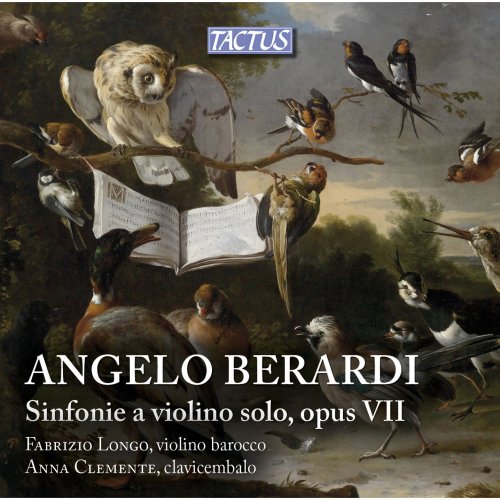
Fabrizio Longo & Anna Clemente - Berardi: Sinfonie a violino solo, Op. 7 (2014)
BAND/ARTIST: Fabrizio Longo, Anna Clemente
- Title: Berardi: Sinfonie a violino solo, Op. 7
- Year Of Release: 2014
- Label: Tactus
- Genre: Classical
- Quality: FLAC (tracks + booklet)
- Total Time: 45:47
- Total Size: 316 MB
- WebSite: Album Preview
Tracklist:
01. Canzone Prima: I. Adagio
02. Canzone Prima: II. Allegro - Presto
03. Canzone Prima: III. Adagio
04. Canzone Prima: IV. Canzone: Allegro - Presto assai
05. Canzone Seconda: I. Grave
06. Canzone Seconda: II. Corrente: Allegro
07. Canzone Seconda: III. Vivace
08. Canzone Seconda: IV. Adagio
09. Canzone Seconda: V. A batuta
10. Canzone Seconda: VI. Balletto allegro
11. Canzone Seconda: VII. Canzone: Allegro - Presto - Presto - Adagio
12. Canzone Terza: I. Vivace
13. Canzone Terza: II. Adagio
14. Canzone Terza: III. Balletto allegro
15. Canzone Terza: IV. Grave
16. Canzone Terza: V. Allegro
17. Canzone Quarta: I. Grave
18. Canzone Quarta: II. Vivace
19. Canzone Quarta: III. Adagio
20. Canzone Quarta: IV. Balletto spiritoso
21. Canzone Quarta: V. Canzone: Allegro
22. Canzone Quinta: I. Allegro: Come sta
23. Canzone Quinta: II. Vivace
24. Canzone Quinta: III. Tremolo
25. Canzone Quinta: IV. Balletto allegro
26. Canzone Sesta: I. Arcate
27. Canzone Sesta: II. Corrente francese
28. Canzone Sesta: III. Tempo furio di sarabanda presto
29. Canzone Sesta: IV. Balletto grave
30. Canzone Sesta: V. Cromatico
31. Canzone Sesta: VI. Tempo di gagliarda
32. Canzone Sesta: VII. Tempo ineguale - Arcate
33. Canzone Sesta: VIII. Tempo inglese
34. Canzone Sesta: IX. Allegro Perfida replicata - Aria Todesca
35. Canzone Sesta: X. Adagio
01. Canzone Prima: I. Adagio
02. Canzone Prima: II. Allegro - Presto
03. Canzone Prima: III. Adagio
04. Canzone Prima: IV. Canzone: Allegro - Presto assai
05. Canzone Seconda: I. Grave
06. Canzone Seconda: II. Corrente: Allegro
07. Canzone Seconda: III. Vivace
08. Canzone Seconda: IV. Adagio
09. Canzone Seconda: V. A batuta
10. Canzone Seconda: VI. Balletto allegro
11. Canzone Seconda: VII. Canzone: Allegro - Presto - Presto - Adagio
12. Canzone Terza: I. Vivace
13. Canzone Terza: II. Adagio
14. Canzone Terza: III. Balletto allegro
15. Canzone Terza: IV. Grave
16. Canzone Terza: V. Allegro
17. Canzone Quarta: I. Grave
18. Canzone Quarta: II. Vivace
19. Canzone Quarta: III. Adagio
20. Canzone Quarta: IV. Balletto spiritoso
21. Canzone Quarta: V. Canzone: Allegro
22. Canzone Quinta: I. Allegro: Come sta
23. Canzone Quinta: II. Vivace
24. Canzone Quinta: III. Tremolo
25. Canzone Quinta: IV. Balletto allegro
26. Canzone Sesta: I. Arcate
27. Canzone Sesta: II. Corrente francese
28. Canzone Sesta: III. Tempo furio di sarabanda presto
29. Canzone Sesta: IV. Balletto grave
30. Canzone Sesta: V. Cromatico
31. Canzone Sesta: VI. Tempo di gagliarda
32. Canzone Sesta: VII. Tempo ineguale - Arcate
33. Canzone Sesta: VIII. Tempo inglese
34. Canzone Sesta: IX. Allegro Perfida replicata - Aria Todesca
35. Canzone Sesta: X. Adagio
Angelo Berardi (Sant’Agata Feltria, Urbino, 1636 – Rome, 1694) was a pupil of Giovan Vincenzo Sarti and Marco Scacchi, of the Roman school, the latter a fundamental figure in his training. Committed supporter of the Seconda Prattica, Berardi maintained that modern music had reached “greater perfection compared to the past” and that the practice of music was more important than theory. He asserted, moreover, that a good composition should also elevate the soul to virtuous thoughts.
His life’s path wound its way through numerous centres (among them Montefiascone, Viterbo, Tivoli and Spoleto), to the crowning of his career as maestro di cappella in Santa Maria in Trastevere in Rome in 1692, where he died surrounded by numerous cages with canaries and other birds that he left to his pupil Raffaelle [sic] Raffaelli to inherit (one of the twelve heirs of his few things), together with his self portrait.
Berardi was a prolific writer and a very able contrapuntist whose value was, already at that time, extensively recognized, perhaps also because of the careful balance that allowed him to praise the genius of Arcangelo Corelli while maintaining an excellent rapport with the Bolognese Giovanni Paolo Colonna during the years of the famous diatribe between those two.
In terms of his stylistic profile, Berardi shows fantasy and richness of inspiration, so much so that his only work assigned to the violin, and dedicated to Sister Anna Maria Francesca Rossi, Augustinian nun from Viterbo (the Sinfonie a Violino Solo, Book I, Op.7, Bologna, Giacomo Monti 1670), seems to cover the entirety of the instrument’s abilities and expressive variety.
His life’s path wound its way through numerous centres (among them Montefiascone, Viterbo, Tivoli and Spoleto), to the crowning of his career as maestro di cappella in Santa Maria in Trastevere in Rome in 1692, where he died surrounded by numerous cages with canaries and other birds that he left to his pupil Raffaelle [sic] Raffaelli to inherit (one of the twelve heirs of his few things), together with his self portrait.
Berardi was a prolific writer and a very able contrapuntist whose value was, already at that time, extensively recognized, perhaps also because of the careful balance that allowed him to praise the genius of Arcangelo Corelli while maintaining an excellent rapport with the Bolognese Giovanni Paolo Colonna during the years of the famous diatribe between those two.
In terms of his stylistic profile, Berardi shows fantasy and richness of inspiration, so much so that his only work assigned to the violin, and dedicated to Sister Anna Maria Francesca Rossi, Augustinian nun from Viterbo (the Sinfonie a Violino Solo, Book I, Op.7, Bologna, Giacomo Monti 1670), seems to cover the entirety of the instrument’s abilities and expressive variety.
As a ISRA.CLOUD's PREMIUM member you will have the following benefits:
- Unlimited high speed downloads
- Download directly without waiting time
- Unlimited parallel downloads
- Support for download accelerators
- No advertising
- Resume broken downloads


